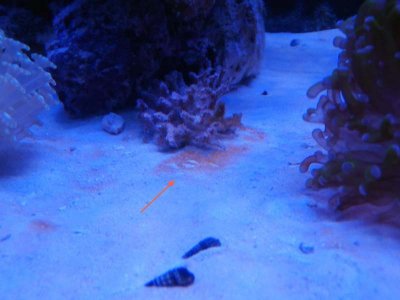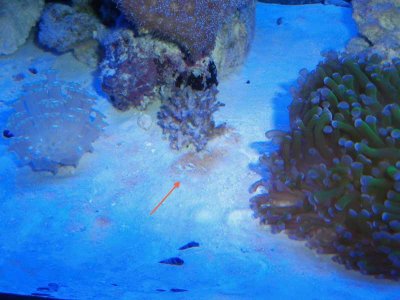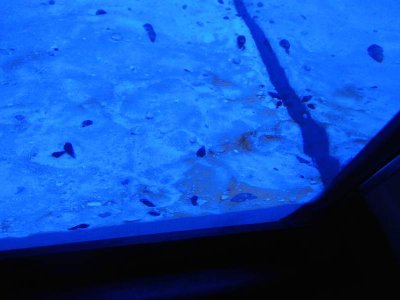You are using an out of date browser. It may not display this or other websites correctly.
You should upgrade or use an alternative browser.
You should upgrade or use an alternative browser.
Dinoflagellates.
- Thread starter DNA
- Start date
DNA
New member
jedimasterben... in 3 days they are back with a vengeance.
At least your experiment contributes important information.
Full tank freshwater exposure does not get rid of dinos.
100% water change does not get rid of dinos.
There could be some long term results so keep looking.
Please don't start over right away for the sake of science.
The completely new saltwater in the tank shows us there is nothing specific with the water chemistry causing dino blooms.
There is bound to be some die off from this causing changes, but in 3 days that would be the effect of a regular new cycle.
Your dinos are from the dark side jedimaster-ben.
At least your experiment contributes important information.
Full tank freshwater exposure does not get rid of dinos.
100% water change does not get rid of dinos.
There could be some long term results so keep looking.
Please don't start over right away for the sake of science.
The completely new saltwater in the tank shows us there is nothing specific with the water chemistry causing dino blooms.
There is bound to be some die off from this causing changes, but in 3 days that would be the effect of a regular new cycle.
Your dinos are from the dark side jedimaster-ben.
jedimasterben
LED world domination!
Instant Ocean. Salt brand is irrelevant, though. If you have any invasive species, they're going to be invasive no matter what salt mix you use as long as they consider your tank to have 'favorable conditions'.It took about a week for the cuprisorb to make a difference.
Btw what salt brand do you use?
There really isn't much else to do, unfortunately. A freshwater soak like that was the ace up my sleeve. Everything in that tank is set to be trashed, save for the maxi mini anemones, but I see no issue with keeping it running until what is in it now is all dead. The gorgonians are gone, most of my zoas (the ones on the plugs) are gone, my big leather is melting away. I've basically just got a few ricordea, a couple mushrooms, and the zoas and palys that I basically started the hobby with that are attached to rocks. Sigh.jedimasterben... in 3 days they are back with a vengeance.
At least your experiment contributes important information.
Full tank freshwater exposure does not get rid of dinos.
100% water change does not get rid of dinos.
There could be some long term results so keep looking.
Please don't start over right away for the sake of science.
The completely new saltwater in the tank shows us there is nothing specific with the water chemistry causing dino blooms.
There is bound to be some die off from this causing changes, but in 3 days that would be the effect of a regular new cycle.
Your dinos are from the dark side jedimaster-ben.
I think for the most part salt mix is irrelevant as well, but I have heard of people switching brands and dino going away. tough thing is so many people have tried different things and think they have pIn pointed the solution. I for an example think cuprisorb is killing my Dino off, but it could be that the dino is just dying off for other reasons.
Your dino seems to be a very tough strain. I thought mine was hard to kill until I started to read about your battle with it.
Your dino seems to be a very tough strain. I thought mine was hard to kill until I started to read about your battle with it.
Squidmotron
New member
I just discovered something that is interesting. Since I have never heard this before in relation to dinos I thought I would pass it along.
Today I added about 15 lbs of pink somoa sand (not live) sand to my refugium. I was curious if there was any particular reason the dinos weren't growing much in my refugium and so thought to recreate the environment of the aquarium above. My refugium never had any substrate. Just caulerpa.
Within 4 hours, dino populations exploded. And I mean exploded. Dinos rose to much larger than normal heights in their usual spots and started covering all the rocks. The substrate began literally bubbling as new dinos formed (even in tank areas where I did not add sand).
(and yes, these are not diatoms -- as you might expect from the addition of sand -- although I wonder if there are both present)
Today I added about 15 lbs of pink somoa sand (not live) sand to my refugium. I was curious if there was any particular reason the dinos weren't growing much in my refugium and so thought to recreate the environment of the aquarium above. My refugium never had any substrate. Just caulerpa.
Within 4 hours, dino populations exploded. And I mean exploded. Dinos rose to much larger than normal heights in their usual spots and started covering all the rocks. The substrate began literally bubbling as new dinos formed (even in tank areas where I did not add sand).
(and yes, these are not diatoms -- as you might expect from the addition of sand -- although I wonder if there are both present)
jedimasterben
LED world domination!
I've attempted to remove as much red from the pictures as possible, but I'm not too proficient in Lightroom just yet, so they're the best I can do at this point. They are your typical 'brown snot'.Jedi, are your dinos really as red as they appear in your pictures, or is that just a visual effect from the lights or camera? And did you have Pants ID them for you?
I was actually planning on sending a sample today since I took today off work, but last night I dumped in ~60mL of peroxide into the 10g tank after the lights went off to kill the hair algae that was taking over, and apparently it hampered their growth today, even now I can't see any dinos growing, they'll come back in a day or two though.
Possibly it had more surface area and a rougher surface to latch on to.I just discovered something that is interesting. Since I have never heard this before in relation to dinos I thought I would pass it along.
Today I added about 15 lbs of pink somoa sand (not live) sand to my refugium. I was curious if there was any particular reason the dinos weren't growing much in my refugium and so thought to recreate the environment of the aquarium above. My refugium never had any substrate. Just caulerpa.
Within 4 hours, dino populations exploded. And I mean exploded. Dinos rose to much larger than normal heights in their usual spots and started covering all the rocks. The substrate began literally bubbling as new dinos formed (even in tank areas where I did not add sand).
(and yes, these are not diatoms -- as you might expect from the addition of sand -- although I wonder if there are both present)
Squidmotron
New member
Possibly it had more surface area and a rougher surface to latch on to.
They exploded everywhere. Over every surface. Not just the surface I added. And the existing colonies increased in size. It was highly interesting.
I'm going to get out the microscope and see if there are diatoms too.
The reason I'm interested in this connection is that some people are actually trying to dose silicants to create diatoms to compete with dinos.
Kieth71
New member
Well I am another week in and dinos still appear to be under control. I am thinking of adding a proper sized uv to make sure they don't reappear. I have done another water change which in past would have caused them to come back with a vengeance. The only thing I have not done is increased the lighting. I am running 6 hours with all lights on and another two with just blues.I have not seen a lot of feedback about using uv but I am seriously thinking about it.
DNA
New member
Some changes are taking place so yesterday I spent two hours watching the interaction between cyanobacteria and dinoflagellates.
We know how Cyanobacteria likes to sit on top of dinos on the sand bed, but are those dead or alive?
Here are some shots from the front glass of my tank.
The white strings are cyano pushing back the brown dinos.
The whole frame covers less than an inch.
The still is a close up from the animation that is taken with an hour interval.


We know how Cyanobacteria likes to sit on top of dinos on the sand bed, but are those dead or alive?
Here are some shots from the front glass of my tank.
The white strings are cyano pushing back the brown dinos.
The whole frame covers less than an inch.
The still is a close up from the animation that is taken with an hour interval.


DNA
New member
Last year I ran a bio pellet reactor and did not have any Cyanobacteria at all.
The dinos ruled the tank and nothing bothered them.
This round I decided not to use it and it's clear to me that cyano and dinos have a relationship.
Cyano likes the dinos and think it's the dead ones mainly. It clearly has an effect on alive ones as well.
---
The changes in my tank:
Dinos left most of the areas they had conquered.
The water cleared and lost it's yellow tint.
Corals that have been dormant show instant improvement in color, growth and polyp extension.
Cyanobacteria now covers most of the favorite dino spots and it changed color from purple to light brown on the sand bed.
I still have some dinos but seem to have lost most of the population.
The dinos ruled the tank and nothing bothered them.
This round I decided not to use it and it's clear to me that cyano and dinos have a relationship.
Cyano likes the dinos and think it's the dead ones mainly. It clearly has an effect on alive ones as well.
---
The changes in my tank:
Dinos left most of the areas they had conquered.
The water cleared and lost it's yellow tint.
Corals that have been dormant show instant improvement in color, growth and polyp extension.
Cyanobacteria now covers most of the favorite dino spots and it changed color from purple to light brown on the sand bed.
I still have some dinos but seem to have lost most of the population.
Chris Abbott
New member
Odd, mine have completely receded from the sandbed and are all but history except for one tiny area. Don't bother asking cause I have no idea at all what happened. I had stooped treating a couple weeks back and they have just slowly retreated.
1panman1
New member
Has anyone had results from adding an algae scrubber. The manufacturer of Santa Monica Filtration claims that Dinos will be the first nuisance algae to go with an algae scrubber. Any experience with this or validity? Would hate to pop for $200-$300 if it will not work, however would be happy to spend that if it works.
jedimasterben
LED world domination!
In theory it should work. I noticed mine cropped up as soon as I removed my algae scrubber and went to a skimmer, but they were already in the system. Turns out that mine are more than likely local and the result of me collecting some macroalgae from a mangrove 'swamp'. Turns out that is a breeding ground for them. Sigh.
wildman926
Active member
Has anyone had results from adding an algae scrubber. The manufacturer of Santa Monica Filtration claims that Dinos will be the first nuisance algae to go with an algae scrubber. Any experience with this or validity? Would hate to pop for $200-$300 if it will not work, however would be happy to spend that if it works.
Yes that is true. But IMHO, their ATS's are for smaller tanks. I have some really nice ones made by a member here on RC. They flat out work, and I have yet to see any return of hair algae, cyano, dino's, etc. I battled hair algae for 8 months. Nuked it with AlgaeFix by API, and installed ATS. My tank is the cleanest it has been in a few years.
1panman1
New member
They have some for large tanks. I was considering a surf 2 for a 75 gallon tank. I would put it in the sump. Any opinions on whether it will get rid of my dino issues? I am open to any other manufactures. Just do not want to do DIY. Have also heard of Turbo Aquatics but Santa Monica seems so easy to place in sump floating. I just want the Dinos to go away.
Last edited:
DNA
New member
Tracing back a few steps.
I raise nitrates and it makes a considerable dent in the dinos.
Algae moves in and covers much of my rocks.
Dinos move back in and sit comfortably on top of the algae.
Cyano really gets going and covers the dinos.
Now I have less than 5% of the dinos left and would call that acceptable.
The algae on the rocks is fading as well.
I the past dinos out-competed the algae and it hardly grew at all.
My tank, a few weeks ago, with lots of algae did have lots of dinos as well at the same time.
I raise nitrates and it makes a considerable dent in the dinos.
Algae moves in and covers much of my rocks.
Dinos move back in and sit comfortably on top of the algae.
Cyano really gets going and covers the dinos.
Now I have less than 5% of the dinos left and would call that acceptable.
The algae on the rocks is fading as well.
I the past dinos out-competed the algae and it hardly grew at all.
My tank, a few weeks ago, with lots of algae did have lots of dinos as well at the same time.
Steveb
Premium Member
Tracing back a few steps.
I raise nitrates and it makes a considerable dent in the dinos.
Algae moves in and covers much of my rocks.
Dinos move back in and sit comfortably on top of the algae.
Cyano really gets going and covers the dinos.
Now I have less than 5% of the dinos left and would call that acceptable.
The algae on the rocks is fading as well.
I the past dinos out-competed the algae and it hardly grew at all.
My tank, a few weeks ago, with lots of algae did have lots of dinos as well at the same time.
Did you use anything in particular to raise your nitrates or just increase feeding and/or less nutrient export?
Hey guys, I've been fighting this thing for 5 months now thinking it was dinos, but now I just don't know if it's dinos, diatoms, cyano, all the above. The pics are not that great but maybe with your experience you can tell me?




